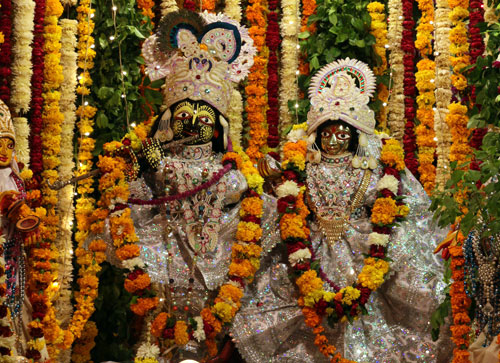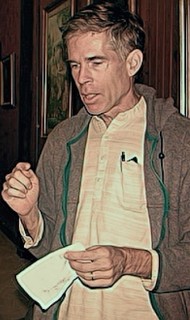Dear TOVP Donors and Well-Wishers,
Please accept our humble obeisances. All glories to Srila Prabhupada.
We at the TOVP would like to extend to you our warmest wishes on Sri Krsna Janmastami, the most auspicious appearance day of Lord Krsna. When the world was in chaos, Krsna personally came to annihilate the demons and to deliver his devotees. He displayed the sweetness and grandeur of his pastimes, gave us the Bhagavad-Gita, and established His devotee Yudhisthira as the emperor of the world. He famously promised:
“One who knows the transcendental nature of My appearance and activities does not, upon leaving the body, take his birth again in this material world, but attains My eternal abode, O Arjuna.”
BG 4.9
Whenever Srila Prabhupada spoke on Janmastami he would begin with this verse, and throughout his books and lectures he quoted it over 730 times. He made it his life’s mission to preach about Krsna. He taught us that Krsna is the Absolute Truth, the original source of creation and the cause of all causes. He is eternally young, all-knowing, and always blissful. All truth, opulence, fame, strength, wisdom and beauty emanate from Him.
“The purpose of this Krsna consciousness movement is to inform everyone that no one is superior to Krsna, God.”
Teachings of Lord Kapila 1
In 1966, Srila Prabhupada celebrated Janmastami in New York with only a small band of fledgling devotees, but today on ISKCON’s 50th anniversary year, millions of people all over the world attend our festivals and hear Krsna’s message. Janmastami marks the beginning of an eternal life of loving devotional service. It’s an opportunity to bring Krsna into the center of our lives by hearing, remembering and discussing His nature and pastimes. By molding our lives in this way, and by engaging our words, activities and resources as much as possible in Krsna’s service, we will surely receive the unlimited mercy that Krsna came to this world to give us.
“With the appearance of Śrī Kṛṣṇa within our heart, we become cleansed of the impurities of material contact, much as the morning appears new and fresh with the appearance of the sun.”
Message of Godhead 2
In this spirit of remembering Krsna’s nature and appearance, and to increase your appreciation for Their Lordships Sri Sri Radha-Madhava, we would like to present the many meanings of the name Madhava, which reflects both the sweetness of Lord Krsna in Vrindavana and the supreme opulence of Lord Vishnu. We will also describe the most prominent Radha-Madhava deities that have been worshipped in our history.
The many meanings of Madhava
The name Madhava is a very prominent name for both Lord Vishnu and Lord Krishna. Srila Prabhupada has translated Madhava in his Bhagavad-gita and Srimad Bhagavatam in many ways: “Husband of the goddess of fortune,” “Master of all energies,” and “He who appears in the Madhu dynasty.” As a name of Vishnu, “Ma” refers to Laksmi and “Dhava” means husband or consort. In reference to Krsna, Madhava is usually explained as coming from the root “Madhu”.
“Srila Sanatana Gosvami has explained the various meanings of the word Madhava as follows: Madhava normally indicates Krsna to be “the Lord, who is the consort of the goddess of fortune, Laksmi.” This name also implies that Lord Krsna descended in the dynasty of Madhu. Since the spring season is also known as Madhava, it is understood that as soon as Lord Krsna entered the Vrndavana forest, it automatically exhibited all the opulences of spring, becoming filled with flowers, breezes and a celestial atmosphere. Another reason Lord Krsna is known as Madhava is that He enjoys His pastimes in madhu, the taste of conjugal love.”
SB 10.15.2
Jayadeva Goswami’s Radha-Madhava
In our Vaishnava history, many important Radha-Madhava deities have been worshipped by famous devotees. The oldest we know about belonged to Jayadeva Goswami, who lived in Navadvipa about 700 years before Lord Caitanya. Jayadeva is described by Srila Prabhupada as a pure devotee and a mahajana, and his Gita-Govinda was relished by Lord Caitanya Himself.

One day as Jayadeva was worshipping Radha-Madhava in Campahati, They appeared before him in a vision and transformed into Lord Gauranga, who is described in the Caitanya-caritamrta as being the same golden color as the campaka flower. Lord Gauranga told him to move to Puri. Many years later Jayadeva Goswami moved to Vrindavana and his deities are still there today in the Radha-Damodara Temple. Srila Prabhupada lived there for six years before coming to the west, and he was trying to organize the construction of a temple for them in 1965.
Bhaktivinode Thakura’s Radha-Madhava
Another important set of Radha-Madhava deities are the family deities of Bhaktivinode Thakur. They were originally worshipped in Bengal by Krsnananda Dutta, who was a disciple of Lord Nityananda and the father of Sri Narottama Dasa Thakur. When Krsnananda retired he moved to Puri, and then settled in the nearby village of Choti. The worship was passed down generation to generation until it came to Bhaktivinode Thakur and Bhaktisiddhanta Sarasvati Thakur.

Unfortunately, after Srila Bhaktisiddhanta’s disappearance the worship became neglected. In about 1950, a neighboring family wanted to claim the land which was in the name of the deities. They stole the deities and buried Them, telling everyone that the deities had become broken and thus had to be submerged in the river.
Although lost for many decades, They were re-discovered in the year 2000 and are now being worshipped in Kendrapara until their new temple can be built in Choti. Every Kartik They travel to Vrindavana to sit on the altar with Radha-Syamasundara in the Krsna Balaram Mandir.
Jaya Radha-Madhava – “This is original Krsna”
Bhaktivinode Thakur published a collection of songs and prayers in 1893 called Gitavali, which included the bhajana we know as “Jaya Radha Madhava”. Srila Prabhupada had a very deep connection with this song, which he introduced after naming the Radha-Madhava deities who are currently worshipped in Mayapur.
While Srila Prabhupada was traveling in India in 1971, he received three sets of Radha-Krsna deities from a gentleman named Mr. Dalmia. Prabhupada sent one set to the ISKCON center in Boston (Radha-Gopivallabha), one to the center in Berkeley (Radha-Gokulananda), and one set (Radha-Madhava) he kept with him. On the 11th of February, 1971, in Gorakhpur, Srila Prabhupada organized an installation ceremony for Sri Radha-Madhava, and introduced the song ‘Jaya Radha-Madhava’ to the devotees. From this time forward, Srila Prabhupada began regularly singing Jaya Radha-Madhava before his lectures.
Over the next three days he elaborated on its meaning. He explained that this song describes the “Original Krsna” in Vrindavana.
“This is actual picture of Krsna, Radha-Madhava giri-vara-dhari. Original Krsna this is. Radha-Madhava giri-vara-dhari. Vraja-jana-vallabha. His business is to please the inhabitants of Vrndavana. That’s all. He has no other business. And the vraja-jana also, they have no other business than to please Krsna. That’s all. This is original Krsna.”
Purport to Jaya Radha-Madhava, February 14, 1971, Gorakhpur
As Satsvarupa recalled in his Prabhupada Lilamrta,
On the third morning after introducing Jaya Radha-Madhava, Prabhupada again sang it with the devotees responding. Then he began to explain it further. Radha-Madhava, he said, have Their eternal loving pastimes in the groves of Vrndavana.
He stopped speaking. His closed eyes flooded with tears, and he began gently rocking his head. His body trembled. Several minutes passed, and everyone in the room remained completely silent. Finally, he returned to external consciousness and said, “Now, just chant Hare Krsna.”
After this, the Radha-Krsna Deities of Gorakhpur became known as Sri Sri Radha-Madhava.
After Srila Prabhupada’s tour concluded, Radha-Madhava were worshipped in Calcutta for a year. In 1972, Srila Prabhupada brought the deities to Mayapur for the first International Gaura-Purnima festival, and told the devotees that They should stay in Mayapur.
Prabhupada Lilamrta
Mayapur Radha-Madhava with Astasakhis
Srila Prabhupada wanted big deities for the Mayapur temple: Madhava should be 5′ 10″ and black marble; Radharani should be 5′ 81/2″ and white marble. He said their pose should be like that of the small Deities. Although They did not appear during his lifetime, he nevertheless set their arrival in motion.

In 1978, Prabhupada came in a dream to a wealthy industrialist and ISKCON devotee named Radhapada Dasa. Srila Prabhupada asked him to help the Mayapur devotees, which inspired him to sponsor the carving of the large Radha-Madhava deities. They were carved in Jaipur, and installed in Mayapur during the 1980 Gaura Purnima festival. Four of the gopis were installed in 1986, and four in 1992. So the small Radha-Madhava deities have been in Mayapur for 44 years, and the large deities for 36 years.
Radha-Madhava’s new home
Krsna’s position as the most worshipable Person in the Universe was clearly established at the Rajasuya sacrifice. The Pandavas conquered the entire planet and collected tribute from everyone in order to accomplish this. Yudhisthira was not motivated by personal fame, ambition or ego. He simply desired that Krsna should be exalted and worshipped in front of all the important kings, sages and demigods of the universe.
As the Pandavas engaged the wealth of the planet in worshipping Krsna by honoring Him at the Rajasuya Yajna, we at the TOVP are trying to follow in their footsteps by raising funds from all directions to build a grand temple for Sri Sri Radha-Madhava that will spread Their name and fame throughout the world.
Construction is pushing ahead steadily and the concrete layers on the three domes are nearly complete. Our monthly construction budget is about half a million US Dollars. We have already made many of the stainless steel supports for the kalashas, which will be the prominent gold-plated peaks of the TOVP. This unique monument will attract millions of souls to come and learn about Krsna. 2016 is the auspicious year of ISKCON’s fiftieth anniversary, and Krsna’s appearance day is the perfect time for us all to do our best, according to our capacity, to complete His new home in Mayapur.
We are grateful for the help of all our donors, both large and small, in this regard. This month, please consider giving a larger portion of your pledge than the usual monthly payment. This will go a long way towards helping us complete the domes so we can thereafter begin the interior finishing work. As Srila Prabhupada used to say with regard to the nightly dictations he made to write his many books, ‘Little drops of water wear away a stone.” Let us all do what we can to assure that Krishna’s glories are known and celebrated for hundreds of years.
Yours in the Service of Sridham Mayapur,
Braja Vilas das
Global Fundraising Director
*protected email*
The post Janmastami 2016 appeared first on Temple of the Vedic Planetarium.
 By Beige Luciano-Adams
By Beige Luciano-Adams





 By Bhanu Swami
By Bhanu Swami
 By Sadaputa dasa
By Sadaputa dasa By Braja Vilas das
By Braja Vilas das












 By Bhurijana Dasa
By Bhurijana Dasa
